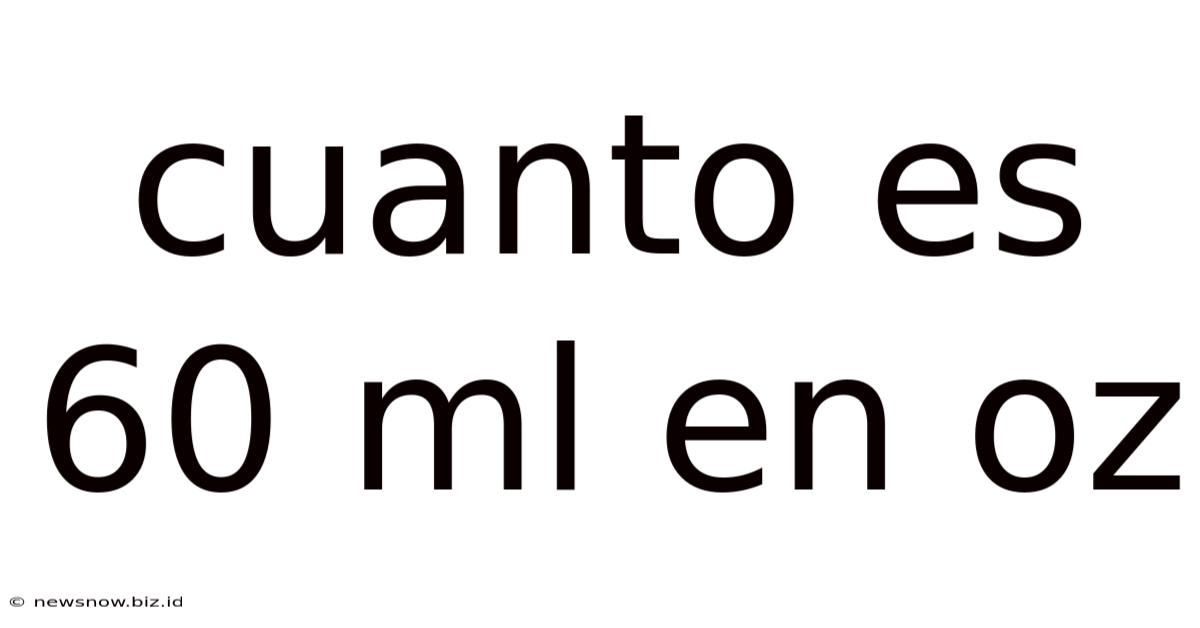Cuanto Es 60 Ml En Oz
New Snow
May 11, 2025 · 4 min read

Table of Contents
How Much is 60 ml in oz? A Comprehensive Guide to Metric and Imperial Conversions
Knowing how to convert between metric (milliliters, liters) and imperial (ounces, pints, gallons) units is crucial in various situations, from cooking and baking to understanding medication dosages and even international travel. This comprehensive guide will delve into the conversion of 60 ml to oz, explaining the process, providing useful context, and offering tips for future conversions.
Understanding the Units
Before we dive into the conversion, let's clarify the units involved:
- Milliliter (ml): A unit of volume in the metric system. It's a thousandth of a liter (1 liter = 1000 ml).
- Ounce (oz): A unit of volume in the imperial system. There are fluid ounces (fl oz) and avoirdupois ounces (used for weight). In the context of volume, we're always referring to fluid ounces.
The key difference lies in the systems themselves. The metric system is based on powers of 10, making conversions relatively straightforward. The imperial system, on the other hand, uses a more complex and less intuitive system of units.
Calculating 60 ml to oz
The exact conversion factor between milliliters and fluid ounces is approximately 29.5735 ml per fluid ounce. This means that 1 fluid ounce is equal to roughly 29.57 ml.
To convert 60 ml to fluid ounces, we can use the following formula:
Fluid ounces = Milliliters / 29.5735
Therefore, 60 ml / 29.5735 ml/oz ≈ 2.03 fluid ounces
Rounding and Precision
In many practical situations, rounding to a certain number of decimal places is necessary. For example, when measuring ingredients for a recipe, rounding to one decimal place (2.0 oz) might be sufficient. However, for more precise applications like medical dosages, retaining more decimal places would be crucial.
Practical Applications of the Conversion
Understanding this conversion can be invaluable in various everyday situations:
1. Cooking and Baking: Many recipes, especially those originating from different countries, use either metric or imperial units. Being able to seamlessly convert between these systems ensures accurate measurements and successful results. For example, if a recipe calls for 60ml of milk, you can easily substitute with approximately 2.03 fl oz.
2. Medicine and Healthcare: Accurate dosage is critical in medicine. Converting between milliliters (often used for liquid medications) and fluid ounces can be essential for ensuring the correct amount of medication is administered.
3. Travel: Different countries use different measurement systems. Understanding conversions is vital when dealing with liquid containers, especially when traveling by air, as limitations are usually expressed in milliliters or ounces.
4. Science and Engineering: In scientific and engineering fields, accurate conversions are paramount for consistent and reliable results. Many experiments and calculations require precise measurements and the ability to translate between different unit systems.
Beyond 60 ml: Mastering Other Conversions
While we focused on 60 ml, understanding the fundamental conversion factor allows you to easily convert other milliliter values to ounces, or vice versa. Simply use the formula:
- Milliliters to Fluid Ounces: Milliliters / 29.5735
- Fluid Ounces to Milliliters: Fluid Ounces * 29.5735
Tips for Accurate Conversions:
- Use a reliable calculator: Online calculators and conversion tools can provide accurate results, especially for complex conversions.
- Understand significant figures: Consider the precision of your measurement when rounding your answer.
- Double-check your work: Always verify your conversion using a different method or tool.
- Context matters: The level of precision required for a conversion depends greatly on the context. For a casual recipe, rounding to one decimal place is usually sufficient. For scientific experiments, however, more precision is necessary.
Frequently Asked Questions (FAQs)
Q: Is 60 ml exactly equal to 2.03 fl oz?
A: No, it's an approximation. The conversion factor is an irrational number, meaning the decimal representation goes on infinitely. 2.03 fl oz is a rounded value.
Q: Why are there different conversion factors sometimes cited?
A: Slight variations in conversion factors may arise from using different rounding methods or slightly different approximations of the conversion constant.
Q: Are there online tools to perform these conversions?
A: Yes, many websites and apps offer free metric-imperial conversion tools.
Q: What about converting larger volumes like liters to gallons?
A: While this guide focuses on milliliters and ounces, the principles remain the same. You'll simply need to use the appropriate conversion factor between the units in question. You can find those factors easily through online search engines or conversion tools.
Conclusion:
Converting 60 ml to oz, and mastering metric-imperial conversions in general, is a valuable skill with broad practical applications. By understanding the principles, using accurate conversion factors, and employing appropriate rounding methods, you can ensure accurate measurements and successful outcomes in various aspects of life. Remember to always consider the context and required precision when performing these conversions. The ability to easily move between these systems will undoubtedly enhance your capabilities in cooking, medicine, travel, science, and countless other areas.
Latest Posts
Related Post
Thank you for visiting our website which covers about Cuanto Es 60 Ml En Oz . We hope the information provided has been useful to you. Feel free to contact us if you have any questions or need further assistance. See you next time and don't miss to bookmark.